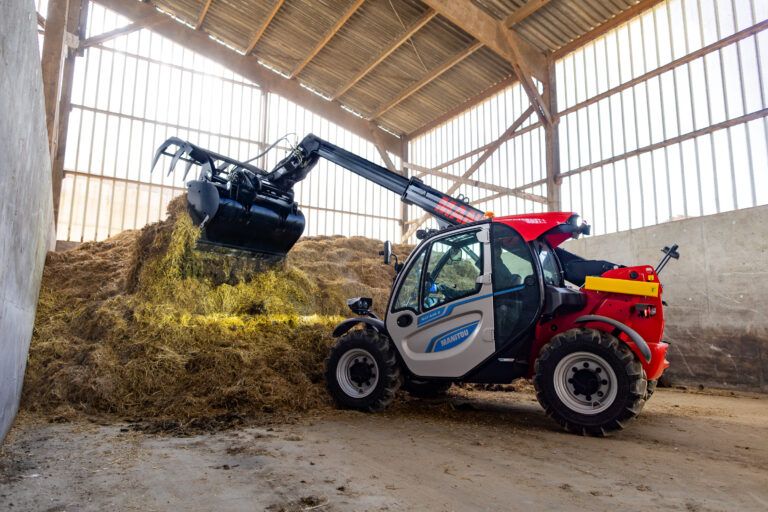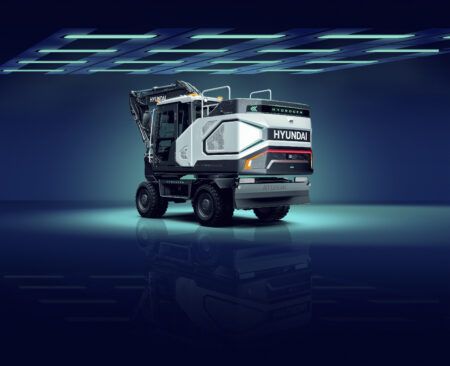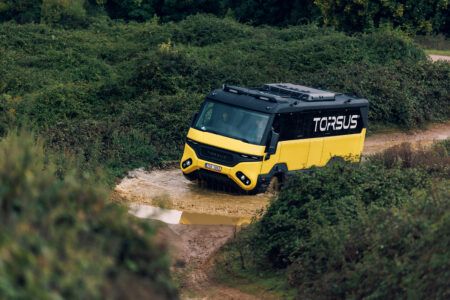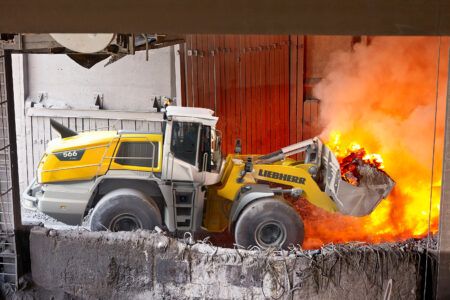French OEM Manitou Group is adding to its range of electric telehandlers with a zero-emission version of one of its best-selling diesel vehicles for agriculture. Here we get a first look at the machine and find out more about the thinking behind its innovative powertrain
Manitou Group is continuing the drive towards electrifying the off-highway sector with its brand new MLT 625e, its first battery electric fixed telehandler for the agricultural sector.
The vehicle, which is based on the MLT 625 H diesel equivalent, is powered by a lithium-ion battery accompanied by two electric motors. The agricultural version has a 9kW integrated battery charger as standard which means fast charging is more easily achieved than earlier electric models. Like its diesel counterpart, the MLT 625e is well adapted to the agricultural industry with an oscillating rear axle, agricultural tyres, a high ground clearance of 38cm and four wheel drive. It also comes with a full range of ag attachments including a bucket, grapple bucket, big bag handler, sweeper and bale clamp.
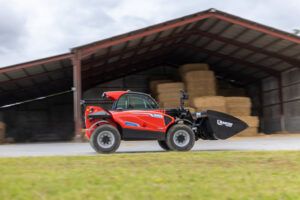
This innovative vehicle adds further benefits for farmers, with zero fumes making it ideal for work in close proximity with animals and other workers. The low noise also minimises disruption. When the Group looked at the design of the MLT 625e, it involved much more than just simply swapping the engine for a battery pack. One of the most innovative features is the central positioning of the battery pack, which not only protects the battery from potential damage during operation, but also enhances the machine’s stability by centralising the weight which is crucial during lifting operations.
Rather than simply retrofitting an existing diesel model, Manitou redesigned the chassis to accommodate the battery pack. This ground-up approach to design ensures the electric telehandler can fully capitalise on the benefits of its power source.
At the core of the MLT 625e is a lithium-ion battery which is designed to provide four hours of continuous work time. The machine’s power management system constantly monitors and adjusts output to maximise efficiency and battery life.
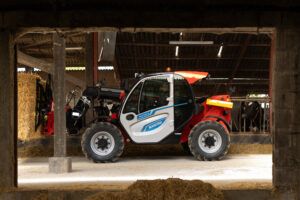
“In the diesel version, we had the hydraulic pump mounted directly on the engine itself so the engine was always running,” says Damien Rolland, head of the engineering department at the super compact telehandlers product unit. “In the electric version, we have a dedicated motor for the hydraulic system. This means that when the operator is not requesting anything, the machine does not run.”
“When hydraulic movement is needed, the electric motor starts running and it is linked directly to the operator’s needs. For example, when the operator wants to make a slow movement, the motor runs slower and when the user needs full power, the motor will operate at top speed. The energy consumption really depends on the operator’s requests.”
Battery recharging is assisted by the on-board 9kW charger, which means the machine can be fully charged in around three hours using a 380V plug. For added convenience, the telehandler comes equipped with adapters for both 380V and 220V plugs, ensuring compatibility with various farm setups.
The fast-charging capability reduces downtime and increases overall productivity. The flexibility in charging also allows farmers to integrate the MLT 625e seamlessly into their daily operations without the need for major infrastructure changes. “Opportunity charging means we can charge the machine whenever we want and it also means that we do not have to fully charge the machine each time,” says Camille Rouvrais, a product manager at Manitou Group. “There is no specific charging room needed or additional maintenance.”
“We have a dedicated motor for the hydraulic system. This means that when the operator is not requesting anything, the machine doesn’t run”
The MLT 625e has been designed to match the capabilities of its diesel counterpart with a lifting capacity of 2,500kg and maximum lifting height of 5.9m, as well as its overall hydraulic performance.
“Compared to the diesel version, the traction power is slightly reduced,” says Rolland. “Nevertheless, the electric version is much more reactive, so we don’t feel we have a significant loss of power. The power is more than enough for agricultural applications.”
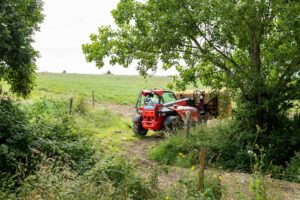
Safety features
The MLT 625e incorporates advanced features to protect both the operator and the machine. The integration of a battery management system (BMS) is at the heart of these safety measures.
The real-time communication between the BMS and the machine’s central control system makes power output adjustments based on battery conditions and operator demands. If the battery charge is low or if temperature conditions are suboptimal, the system can limit power output to prevent damage and ensure continued operation.
“The BMS sends information to the machine’s system. The system then assesses the operator’s request and the battery capacity and adapts the request accordingly. If the request is in balance with the battery capacity, the movement will be as requested. If the battery cannot deliver the power needed, the movement will be reduced,” says Rolland.
The MLT 625e also features thermal management systems to maintain optimal battery temperature. A small radiator and fan system help regulate the temperature of the traction motor and hydraulic oil, while also providing cooling for electrical components in the vehicle.
“Opportunity charging means we can charge the machine whenever we want and do not have to fully charge it each time”
Furthermore, Manitou Group has implemented measures to protect the electrical components from dust, debris and moisture which could potentially cause wear and damage and are constant hazards in agricultural. “All the electrical components have an IP65 rating and most of them are located under the engine bonnet to protect them from rain, dirt, dust and debris. We have also designed a cover for
the motor which adds protection against adverse weather conditions,” says Rolland.
The electric powertrain in the MLT 625e means much less maintenance is needed when compared to a traditional diesel machine, with no need for engine oil changes or fuel filter replacements. This not only reduces downtime, but also lowers the total cost of ownership
for the farmers.
The switch to electric has resulted in a significantly quieter operation. This reduction in noise makes the telehandler well-suited for indoor operations, such as in barns or other enclosed agricultural spaces.
The introduction of the MLT 625e aligns with Manitou Group’s target to have 43% of its product range sold as low emission by 2030. “In terms of sustainability, we are already making moves in the construction sector, and we aim to do exactly the same in the agricultural sector,” says Franck Lethorey, who is external communication manager for the Manitou Group. “We have a dedicated low-carbon pathway which has been validated by the SBTI organisation. It is really important for us to accelerate the deployment of our electric ranges and we are currently in the process of working on hydrogen prototypes. We also have a well-established CSR policy. This may be our first agricultural telehandler launch, but we’re focused on our entire global strategy.”
This article first appeared in the August issue of iVT International – https://markallen.mydigitalpublication.co.uk/publication/?m=63192&i=827328&p=1&pre=1&ver=html5


